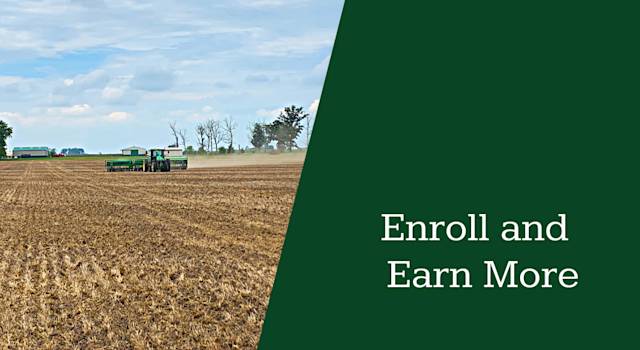
What is the Value of your Crop Residue?
Written by: Zachary Larson, CPAg, ForGround by Bayer Sustainable Systems Agronomist
Summary
While there are some financial benefits from removing and selling of corn or soybean stover, the process comes at a cost, including a lost value in nutrients. Additionally, there are effects that are harder to quantity, but can have meaningful impacts. Before committing to stover removal, consider your potential gains and losses, and keep both short and long-term goals in mind.
Read Time: 4 minutes
Assessing the Value of Your Crop Residue
Corn and soybean stover can have many benefits, including financial ones. However, the decision to remove and sell stover should be weighed against the agronomic value of keeping it in the field. Fortunately, the value calculation is a relatively straightforward one, although the economics may change from year to year depending on residue values and fertilizer prices.
Stover Production Amounts and Costs
The amount of stover produced is typically related to the amount of grain produced, meaning that that higher yielding fields will most likely produce more stover. For corn, approximately 1 ton of stover at 10% moisture is produced for every 40 bushels of grain yield, and for soybeans 1 ton is produced for every 30 bushels of yield. (1) The amount of stover harvested will be less than what’s on the field, with raking and baling removing approximately 66% of stover, while following a combine windrow is approximately 50%. (2) Since soybeans stover is mostly stems, and not all material is harvested, raking and baling will remove less than corn, with 50% or less being a reference point. Therefore, for a typical 200 bushel corn and 60 bushel soybean yield, approximately 3.5 and 1 ton of stover can be harvested, respectively.
Additionally, the direct cost of harvest should be determined when considering harvesting stover. The 2022 Iowa Farm Custom Rate Survey median price for raking is $8/acre, and corn stalk baling is $15/bale for wrapped bales. (3) Many famers note that corn stalks result in more wear and tear on a baler, so custom prices are typically higher for baling stalks than hay, and for those doing it themselves, additional maintenance or repair costs should be expected. Assuming a bale weight 1,500 lbs., raking and baling a ton of corn stalks is approximately $22 per ton, while for soybeans it is approximately $28 for the scenario above, not considering the cost of transport of material from the field.
Cost of Lost Nutrients
Comparable to what is removed in grain, stover also contains macro and micronutrients. While amounts will vary some between management practices and genetics, the numbers in table 1 can be used as a starting point. (4)

Table 1. Value of nutrients contained in corn and soybean stover. Fertilizer prices come from the Illinois Production Cost Summary for 9/22/22, using urea @ $0.43/lb N, MAP @ $0.41/lb P2O5 and potash @ $0.43/lb K2O. S values calculated from AMS @ $590/ton, or $0.24/lb S. For MAP and AMS, an equivalent value of N was discounted @ $0.43/lb.
Corn and soybean stover contain some amount of nitrogen, phosphorus and potassium that translate into fertility value. While nitrogen is present in each crop, this amount may be discounted as it may not be immediately available to the plant as the residue undergoes mineralization to form organic matter. However, as residue breaks down, phosphorus, potassium and sulfur can be become plant-available. Therefore, using the fertility prices above, corn stover has harvest costs and a fertilizer value of over $52 per ton, while soybean harvest costs combined with fertilizer values are around $42 per ton.
Soil Health Benefits of Stover
In addition to the financial benefits of stover, keeping residue on the soil surface provides additional benefits. Maintaining residue to attenuate the impact of raindrop energy and slow the flow of water is critical in reducing soil erosion. Also, the presence of residue helps to lessen the effects of crusting and maintain good infiltration at the soil surface. Residue also serves as a feed source for earthworms and other organisms and cover for insects such as carabid beetles, which are natural predators of crop pests, including slugs. Finally, surface residue is a contributor to the soil organic matter pool, and over time consistent removals of stover may result in declines in organic matter content.
Sources cited 1, 4. Rees, J., Wortman, C., Drewnoski, M., Glewen, K., Pryor, R., and Whitney, T. (2018, December 31). What is the value of soybean residue? University of Nebraska – Lincoln. https://cropwatch.unl.edu/2018/what-value-soybean-residue 2. Lang, B. (2002). Estimating the nutrient value in corn and soybean stover [Fact sheet]. Iowa State University. https://www.extension.iastate.edu/sites/www.extension.iastate.edu/files/clayton/stovervalue.pdf 3. Plastina, A., Johannas, A., Gleisner, A., Qualman, A. (2022). 2022 Iowa Farm Custom Rate Survey. [Fact sheet]. Iowa State University. https://www.extension.iastate.edu/agdm/crops/pdf/a3-10.pdf
Legal Statement ALWAYS READ AND FOLLOW PESTICIDE LABEL DIRECTIONS. Performance may vary, from location to location and from year to year, as local growing, soil and weather conditions may vary. Growers should evaluate data from multiple locations and years whenever possible and should consider the impacts of these conditions on the grower’s fields.
Bayer and Bayer Cross are registered trademarks of Bayer Group. All other trademarks are the property of their respective owners. ©2022 Bayer Group. All rights reserved.


